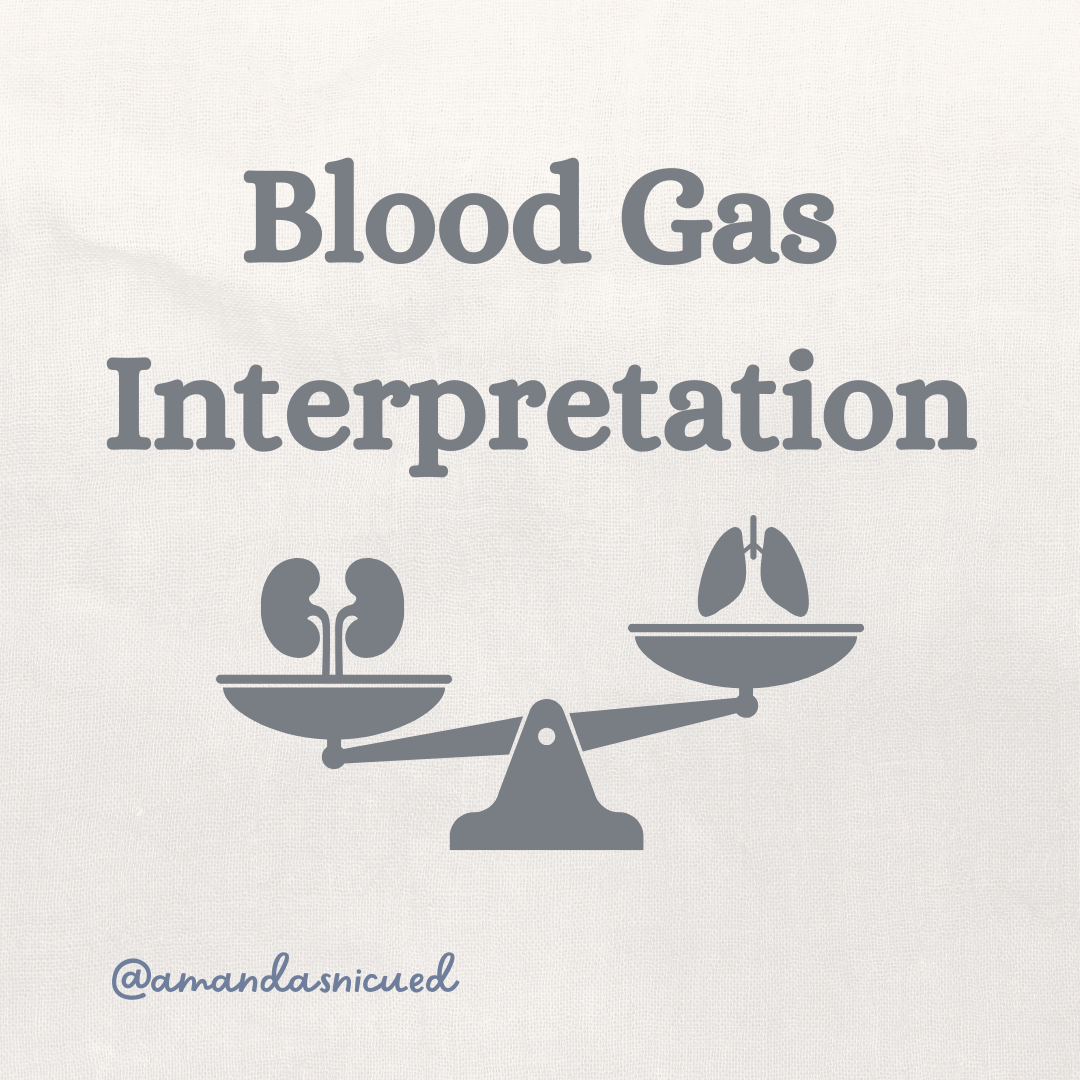Amanda's NICU ED Blogs
RECENT BLOG ARTICLES

Blood Gas Interpretation in the NICU
"Maintaining the pH within the normal range (7.35-7.45) is important for normal cellular function..."
Let's Talk Blood Gasses!
Whenever I talk to NICU nurses who are prepping for the RNC-NIC exam, blood gasses are always top of mind and causing anxiety.
Let's review each component of the blood gas and make this complex topic a little easier to understand.

Components of the Blood Gas:
pH: The pH provides an overall assessment of acid-base status. Is there acidosis or alkalosis? pH reflects the concentrations of extracellular hydrogen (H+) ions.
A higher concentrations of H+ ions results in a lower pH (acidosis).
A lower concentration of H+ ions results in a higher pH (alkalosis).
Maintaining the pH within the normal range (7.35-7.45) is important for normal cellular function throughout the body as it affects the function of proteins and cell membranes. This is important, therefore the arterial chemoreceptors and medulla maintain tight control of the H+ ion concentrations by adjusting ventilation based on the pH, PaO2, and PaCO2. Buffering systems, such as HCO3 produced by the kidneys, also assist with maintaining a normal pH. The ability to compensate and correct pH through ventilation is rapid, however the renal response takes hours to days.
The first step in interpreting a blood gas is determining if the pH is normal, acidotic, or alkalotic. A normal pH is 7.35-7.45, therefore pH <7.35 represents acidosis and pH >7.45 represents alkalosis
CO2: Carbon dioxide (CO2) is the respiratory component of Acid-Base balance and is controlled by alveolar ventilation. CO2 is a byproduct of cellular metabolism that is dissolved into intracellular fluid and transported via the red blood cells to the lungs where it is expelled. Ventilation is the only method of removing carbon dioxide.
When ventilation is not effective, circulating CO2 increases. The excess CO2 dissolved with water forms carbonic acid which then dissociates into a H+ ion, causing a fall in pH.
A normal CO2 value on the blood gas is 35-45 mmHg. A CO2 level >45 mmHg is considered hypercarbia and contributes to acidosis (Respiratory Acidosis)
HCO3: Bicarbonate (HCO3) is a base that can neutralize acid. When HCO3 neutralizes H+ it creates carbonic acid, which dissociates into water and CO2 and is eliminated. HCO3, unlike pH and CO2, is a calculated value on the blood gas not a directly measured value.
The normal HCO3 values are 22-26 mEq/L, however in the first 48 hours of life lower levels are normal (19-22 mEq/L)
Extremely preterm infants often develop metabolic acidosis because of renal bicarbonate losses in the first weeks after birth. Chronic increase in PaCO2 (e.g. babies with BPD) eventually leads to increased HCO3 as the body attempts to compensate for the hypercarbia.
Base excess/deficit: The base excess/deficit refers to the amount of acid or base required to return the pH to 7.4, in a setting of a normal PaCO2.
Normal values of base range from about -2 to +2
A little bit about oxygenation 🤓
PaO2: The PaO2 represents the oxygen dissolved within the plasma of the blood and provides information about the oxygenation status. Oxygenation is an important component that is related to, but also distinct from, ventilation. Oxygenation at the tissue level is reliant on oxygen delivery and oxygen consumption. Oxygen delivery relies on cardiac output and oxygen carrying capacity of the blood. Oxygen consumption is determined based on the tissues metabolic needs.
PaO2 can only be accurately measured from arterial blood, therefore when an arterial blood gas is not available, pulse oximetry is used to identify hypoxemia. Hypoxemia refers to reduced levels of oxygen in arterial blood. Hypoxia, reduced oxygenation at the tissue level, is assessed based on clinical signs of illness including signs of perfusion and lactate levels.
Keep in mind that pulse oximetry is only estimating the amount of oxygen bound to hemoglobin. The affinity of hemoglobin to oxygen, or its ability to release oxygen to the tissues, is dependent on many factors. Hypothermia, alkalemia, hypocapnea, and the presence of fetal hemoglobin increase the affinity of hemoglobin to oxygen. In other words, it holds on to oxygen tightly and doesn't want to release it to the tissues. Hyperthermia, acidosis, and hypercapnea all increase hemoglobins affinity for oxygen, meaning it readily releases oxygen to the tissue. How do you think these might affect what you see at the bedside? If you have a patient who is hyperthermic or hypothermic, what might to see on the pulse oximeter?

Wishing you all the best!
Amanda xoxo
Missed my other newsletters? Click here to read them!
Let's Study Together! Join my Certification Course
References:
Fraser, D. & Diehl-Jones, W. (2021). Assisted Ventilation in Core Curriculum for Neonatal Intensive Care (6th Ed.) Elsevier
Barry, J., Deacon, J., Hernandez, C., & Jones, M. D. (2021). Acid-Base Homeostasis and Oxygenation in Merenstein & Gardner's Handbook of Neonatal Intensive Care (9th Ed). Elsevier
Travers, C., & Ambalavanan, N. (2022). Blood gases: Technical aspects and interpretation in Goldsmith's Assisted Ventilation of the Neonate (7th Ed.) Elsevier
Respiratory and Blood Gas Blogs

Blood Gas Interpretation in the NICU
"Maintaining the pH within the normal range (7.35-7.45) is important for normal cellular function..."
Let's Talk Blood Gasses!
Whenever I talk to NICU nurses who are prepping for the RNC-NIC exam, blood gasses are always top of mind and causing anxiety.
Let's review each component of the blood gas and make this complex topic a little easier to understand.

Components of the Blood Gas:
pH: The pH provides an overall assessment of acid-base status. Is there acidosis or alkalosis? pH reflects the concentrations of extracellular hydrogen (H+) ions.
A higher concentrations of H+ ions results in a lower pH (acidosis).
A lower concentration of H+ ions results in a higher pH (alkalosis).
Maintaining the pH within the normal range (7.35-7.45) is important for normal cellular function throughout the body as it affects the function of proteins and cell membranes. This is important, therefore the arterial chemoreceptors and medulla maintain tight control of the H+ ion concentrations by adjusting ventilation based on the pH, PaO2, and PaCO2. Buffering systems, such as HCO3 produced by the kidneys, also assist with maintaining a normal pH. The ability to compensate and correct pH through ventilation is rapid, however the renal response takes hours to days.
The first step in interpreting a blood gas is determining if the pH is normal, acidotic, or alkalotic. A normal pH is 7.35-7.45, therefore pH <7.35 represents acidosis and pH >7.45 represents alkalosis
CO2: Carbon dioxide (CO2) is the respiratory component of Acid-Base balance and is controlled by alveolar ventilation. CO2 is a byproduct of cellular metabolism that is dissolved into intracellular fluid and transported via the red blood cells to the lungs where it is expelled. Ventilation is the only method of removing carbon dioxide.
When ventilation is not effective, circulating CO2 increases. The excess CO2 dissolved with water forms carbonic acid which then dissociates into a H+ ion, causing a fall in pH.
A normal CO2 value on the blood gas is 35-45 mmHg. A CO2 level >45 mmHg is considered hypercarbia and contributes to acidosis (Respiratory Acidosis)
HCO3: Bicarbonate (HCO3) is a base that can neutralize acid. When HCO3 neutralizes H+ it creates carbonic acid, which dissociates into water and CO2 and is eliminated. HCO3, unlike pH and CO2, is a calculated value on the blood gas not a directly measured value.
The normal HCO3 values are 22-26 mEq/L, however in the first 48 hours of life lower levels are normal (19-22 mEq/L)
Extremely preterm infants often develop metabolic acidosis because of renal bicarbonate losses in the first weeks after birth. Chronic increase in PaCO2 (e.g. babies with BPD) eventually leads to increased HCO3 as the body attempts to compensate for the hypercarbia.
Base excess/deficit: The base excess/deficit refers to the amount of acid or base required to return the pH to 7.4, in a setting of a normal PaCO2.
Normal values of base range from about -2 to +2
A little bit about oxygenation 🤓
PaO2: The PaO2 represents the oxygen dissolved within the plasma of the blood and provides information about the oxygenation status. Oxygenation is an important component that is related to, but also distinct from, ventilation. Oxygenation at the tissue level is reliant on oxygen delivery and oxygen consumption. Oxygen delivery relies on cardiac output and oxygen carrying capacity of the blood. Oxygen consumption is determined based on the tissues metabolic needs.
PaO2 can only be accurately measured from arterial blood, therefore when an arterial blood gas is not available, pulse oximetry is used to identify hypoxemia. Hypoxemia refers to reduced levels of oxygen in arterial blood. Hypoxia, reduced oxygenation at the tissue level, is assessed based on clinical signs of illness including signs of perfusion and lactate levels.
Keep in mind that pulse oximetry is only estimating the amount of oxygen bound to hemoglobin. The affinity of hemoglobin to oxygen, or its ability to release oxygen to the tissues, is dependent on many factors. Hypothermia, alkalemia, hypocapnea, and the presence of fetal hemoglobin increase the affinity of hemoglobin to oxygen. In other words, it holds on to oxygen tightly and doesn't want to release it to the tissues. Hyperthermia, acidosis, and hypercapnea all increase hemoglobins affinity for oxygen, meaning it readily releases oxygen to the tissue. How do you think these might affect what you see at the bedside? If you have a patient who is hyperthermic or hypothermic, what might to see on the pulse oximeter?

Wishing you all the best!
Amanda xoxo
Missed my other newsletters? Click here to read them!
Let's Study Together! Join my Certification Course
References:
Fraser, D. & Diehl-Jones, W. (2021). Assisted Ventilation in Core Curriculum for Neonatal Intensive Care (6th Ed.) Elsevier
Barry, J., Deacon, J., Hernandez, C., & Jones, M. D. (2021). Acid-Base Homeostasis and Oxygenation in Merenstein & Gardner's Handbook of Neonatal Intensive Care (9th Ed). Elsevier
Travers, C., & Ambalavanan, N. (2022). Blood gases: Technical aspects and interpretation in Goldsmith's Assisted Ventilation of the Neonate (7th Ed.) Elsevier
Cardiac Blogs

Blood Gas Interpretation in the NICU
"Maintaining the pH within the normal range (7.35-7.45) is important for normal cellular function..."
Let's Talk Blood Gasses!
Whenever I talk to NICU nurses who are prepping for the RNC-NIC exam, blood gasses are always top of mind and causing anxiety.
Let's review each component of the blood gas and make this complex topic a little easier to understand.

Components of the Blood Gas:
pH: The pH provides an overall assessment of acid-base status. Is there acidosis or alkalosis? pH reflects the concentrations of extracellular hydrogen (H+) ions.
A higher concentrations of H+ ions results in a lower pH (acidosis).
A lower concentration of H+ ions results in a higher pH (alkalosis).
Maintaining the pH within the normal range (7.35-7.45) is important for normal cellular function throughout the body as it affects the function of proteins and cell membranes. This is important, therefore the arterial chemoreceptors and medulla maintain tight control of the H+ ion concentrations by adjusting ventilation based on the pH, PaO2, and PaCO2. Buffering systems, such as HCO3 produced by the kidneys, also assist with maintaining a normal pH. The ability to compensate and correct pH through ventilation is rapid, however the renal response takes hours to days.
The first step in interpreting a blood gas is determining if the pH is normal, acidotic, or alkalotic. A normal pH is 7.35-7.45, therefore pH <7.35 represents acidosis and pH >7.45 represents alkalosis
CO2: Carbon dioxide (CO2) is the respiratory component of Acid-Base balance and is controlled by alveolar ventilation. CO2 is a byproduct of cellular metabolism that is dissolved into intracellular fluid and transported via the red blood cells to the lungs where it is expelled. Ventilation is the only method of removing carbon dioxide.
When ventilation is not effective, circulating CO2 increases. The excess CO2 dissolved with water forms carbonic acid which then dissociates into a H+ ion, causing a fall in pH.
A normal CO2 value on the blood gas is 35-45 mmHg. A CO2 level >45 mmHg is considered hypercarbia and contributes to acidosis (Respiratory Acidosis)
HCO3: Bicarbonate (HCO3) is a base that can neutralize acid. When HCO3 neutralizes H+ it creates carbonic acid, which dissociates into water and CO2 and is eliminated. HCO3, unlike pH and CO2, is a calculated value on the blood gas not a directly measured value.
The normal HCO3 values are 22-26 mEq/L, however in the first 48 hours of life lower levels are normal (19-22 mEq/L)
Extremely preterm infants often develop metabolic acidosis because of renal bicarbonate losses in the first weeks after birth. Chronic increase in PaCO2 (e.g. babies with BPD) eventually leads to increased HCO3 as the body attempts to compensate for the hypercarbia.
Base excess/deficit: The base excess/deficit refers to the amount of acid or base required to return the pH to 7.4, in a setting of a normal PaCO2.
Normal values of base range from about -2 to +2
A little bit about oxygenation 🤓
PaO2: The PaO2 represents the oxygen dissolved within the plasma of the blood and provides information about the oxygenation status. Oxygenation is an important component that is related to, but also distinct from, ventilation. Oxygenation at the tissue level is reliant on oxygen delivery and oxygen consumption. Oxygen delivery relies on cardiac output and oxygen carrying capacity of the blood. Oxygen consumption is determined based on the tissues metabolic needs.
PaO2 can only be accurately measured from arterial blood, therefore when an arterial blood gas is not available, pulse oximetry is used to identify hypoxemia. Hypoxemia refers to reduced levels of oxygen in arterial blood. Hypoxia, reduced oxygenation at the tissue level, is assessed based on clinical signs of illness including signs of perfusion and lactate levels.
Keep in mind that pulse oximetry is only estimating the amount of oxygen bound to hemoglobin. The affinity of hemoglobin to oxygen, or its ability to release oxygen to the tissues, is dependent on many factors. Hypothermia, alkalemia, hypocapnea, and the presence of fetal hemoglobin increase the affinity of hemoglobin to oxygen. In other words, it holds on to oxygen tightly and doesn't want to release it to the tissues. Hyperthermia, acidosis, and hypercapnea all increase hemoglobins affinity for oxygen, meaning it readily releases oxygen to the tissue. How do you think these might affect what you see at the bedside? If you have a patient who is hyperthermic or hypothermic, what might to see on the pulse oximeter?

Wishing you all the best!
Amanda xoxo
Missed my other newsletters? Click here to read them!
Let's Study Together! Join my Certification Course
References:
Fraser, D. & Diehl-Jones, W. (2021). Assisted Ventilation in Core Curriculum for Neonatal Intensive Care (6th Ed.) Elsevier
Barry, J., Deacon, J., Hernandez, C., & Jones, M. D. (2021). Acid-Base Homeostasis and Oxygenation in Merenstein & Gardner's Handbook of Neonatal Intensive Care (9th Ed). Elsevier
Travers, C., & Ambalavanan, N. (2022). Blood gases: Technical aspects and interpretation in Goldsmith's Assisted Ventilation of the Neonate (7th Ed.) Elsevier
hey nurses don't miss out
© Copyright 2024. AmandasNICUEd. All rights reserved. | Terms & Conditions | Privacy Policy Contact: [email protected]


